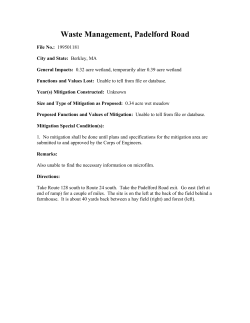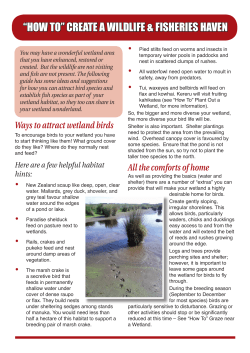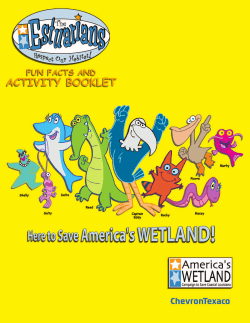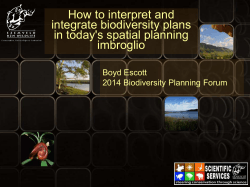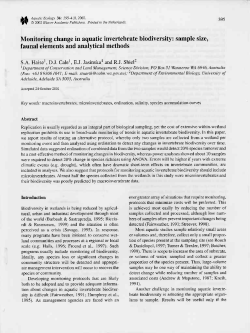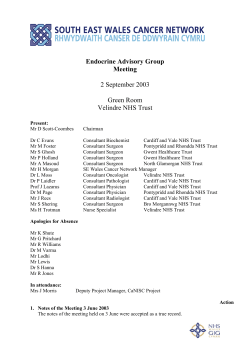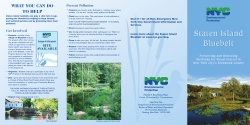
How to Hire the Right Wetlands Consultant ^
As previously printed in Wetland News, June-July 2007, Association of State Wetland Managers, Inc. How to Hire the Right Wetlands Consultant ^ Part 2 of the Wetland Permit Series By Leah Stetson, ASWM Raccoon at Brownfield Bog, Saco River, Maine, May 2007. Jeanne Christie photo Step 1: Do I Need to Hire a Wetlands Consultant? Individual landowners and developers who are planning a project that will alter or fill a wetland, stream or other water body, or who wish to avoid having an impact to those areas, may consider hiring a consultant. A consultant can help the landowner meet the requirements of Section 404 of the Clean Water Act (CWA), and/or similar state, local or tribal programs. The first obvious step might be to visit the town office or city hall, where a landowner may describe the proposed project and find out whether it will require a local government permit. In addition, ask whether the proposed activities and/or the wetland in question are covered under state or federal wetland laws. Contact your state wetland agency or Corps District office to get a description of the activities that require state and federal permits. Many Corps Districts and state agencies have information on their websites about dredge and fill permit programs. Depending on the project, an applicant may need a consultant to help with other aspects of the permit application process, not just filing the paperwork. Wetland delineations and mitigation site design are likely required components of most proposed larger projects. A consultant with a good background in hydrology, soil science, ecology and botany who 1) is able to apply that knowledge to identify (delineate) wetlands, 2) has a working relationship with regulatory staff and 3) is familiar with the techniques used by state and federal regulatory agencies, is probably a good candidate. But it is wise to ask for references and to see a client list. What do you know? It is beneficial for any permit applicant to familiarize himself or herself with local, state and federal regulations on dredge and fill activities. Visit a local conservation commission, or the state’s website, or by visiting ASWM’s webpage on dredge and fill programs at: http://www.aswm.org/member/wetlandnews/april_2007/dredge_&_fill_0407.htm What does a wetlands consultant do? First there are several different types of wetlands consultants. Some do wetland mitigation, some do not. One may be more familiar with local wetlands than another consultant from a different region of the country. A typical consultant can provide the following services (but not necessarily all of them): Preliminary site visits and research to determine if wetlands are present and whether a full wetland delineation is necessary Wetland delineation (find the boundaries of the wetland) Accurately map areas that will fall under the wetland permit requirements Prepare or contribute to site development designs that integrate development goals with wetland and stream protection Advise a client on state and federal wetland permit requirements and options Handle all technical aspects of a permit application, including the alternatives analysis and compensatory mitigation plan Implement the mitigation plan, including the jobs of instructing and monitoring heavy equipment operators, planting, annual monitoring (follow-up) and preparing monitoring reports for state regulatory agencies and the Corps, as required1 Several wetland consultants said that a good way to find a consultant is by attending a class offered by a local college, continuing education program or conservation organization. While most permit applicants may not have the time to do this, if there is an opportunity to take a one or two-day introductory wetlands course, it is a good way to learn about wetlands and meet others who are going through the permit process, too, as well as to connect with prospective consultants. Besides the classroom, there are other ways to find the right consultant. Although certain information may be gained by an Internet search, avoid judging a wetlands consultant or firm solely on its website; even failed projects can look good in cropped photos and bulleted descriptions. It is important to ask other professionals about the firm or consultant and to get others’ opinions on the project experience in a consultant’s portfolio. Start by contacting the agency that regulates wetlands in your state. Agency staff rarely (and may not be permitted to) gives specific recommendations as to which consultants are the best. Some questions, however, are good to ask. The following questions are objective with answers that are based on public information: Questions for Regulatory Agency Staff: a. Ask for a list of consultants with whom this agency often works. Again, an agency staff person cannot make a recommendation but may refer permit applicants to a well-known consultant or a few names from a longer list of available consultants. 1 List adapted from Oregon Division of State Lands’ Wetlands Program brochure, “Just the Facts—Choosing and Using a Wetlands Consultant.” May 2000 http://statelands.dsl.state.or.us Jeanne Christie photo Step 2: How to Find the Right Wetlands Consultant b. Does this consultant turn in complete permit applications the first time? c. What percent of the delineations and/or applications this person has submitted have been approved or accepted without required revisions? Anything more than one required revision is cause for concern. Remember: the quality of the applications is important, not the quantity. The overall number of delineations or permit applications submitted usually has no bearing on the quality of work done, unless the number is very low due to a consultant’s lack of experience. d. Does this consultant have a history of receiving letters of deficiency from this agency? It is important to work with a consultant who pays attention to detail and does not leave out components of the application, e.g. mitigation plan, delineation, correspondence. e. Is this consultant’s work and dealings with said agency considered professional? f. Is this consultant experienced with this particular agency? Another way to ask this: Does the consultant know the project managers and agency staff by name? State Park, Virginia Beach Jeanne Christie photo a. Is this consultant certified by the Society of Wetland Scientists (SWS) as a Professional Wetland Scientist (P.W.S.) or a Wetland Professional in Training (WPIT)? If the answer is yes, this means the person has met certain educational and experience requirements. It does not necessarily mean that s/he has specific expertise, e.g. wetland delineation or mitigation site design. Alternatively, licensees are listed on the SWS website at: http://www.wetlandcert.org/ b. Is this consultant certified by a state wetland delineator certification program? (NH, VA, WI and MN have such programs currently) If the answer is State Park, Virginia Beach yes, you can find out what was required of those whose work is certified by visiting that program’s website. For links to state delineator certification programs, go to: http://www.aswm.org/member/wetlandnews/june07/certification_0607.htm Jeanne Christie photo Questions for Alternative References: A note about certification: If the consultant says that s/he took a 5 day course through a continuing education program or a series of wetland delineation workshops and then received a certificate of completion, this does not make the consultant a “certified wetland delineator.” Having completed a series of classes may have met part of the requirements for a certificate or license through a state program, or SWS’s Professional Wetland Scientist certification. a Ask prior clients of this consultant if the work was done correctly the first time or if they had to pay extra for additional work, e.g. multiple revisions, site visits. Although references who work for the same consulting firm may be listed, it is probably not the best way to get an opinion of someone’s work. Colleagues will likely speak very highly of one another. Likewise a consultant’s résumé or webpage, while useful for learning about his/her educational background and professional experience, does not give a permit applicant the chance to hear how others have perceived this person’s work. If a client list is available, however, that will be useful when contacting references. Step 3: Communicating the Client’s Needs The most important step is to clearly define in writing what the client wants and needs from the consultant. For a first-time permitee, this step may require outside assistance from an expert such as an attorney or engineer. Ideally this other professional possesses both the experience with local regulatory agencies and staff as well as specific knowledge of wetland permit applications. Things to discuss with the consultant upfront and to ask: a. Does the fee estimate include any revisions or site visit(s) that may be required by the federal, state or local agency? If it does not include revisions or additional site visits, put a limit on additional fees you are willing to pay, e.g. one revision and one additional site visit. It is advantageous to find a competent consultant who will not need to make repeated revisions to the permit application. b. What’s included and what is not included in the estimate? Survey? Written report? Data sheets? Will the consultant fill out the application or just submit it for the client? (This is a key distinction that will affect the cost.) Will the consultant obtain the permit for you? (includes follow-up, as opposed to just submitting it, which does not include follow-up calls, etc.) What amount of money will be required upfront? Half? c. Will the consultant arrange for a pre-application meeting with someone from the regulatory agency? The pre-application meeting is between three parties—the client, the consultant and a representative of the state regulatory agency. This is usually only done for large projects but may be arranged for smaller projects if the client requests it. For this meeting the first proposal is preliminary but it may save the client time and money to find out from the regulatory agency what is required. The client will have to pay for the pre- application meeting. This puts less risk on the consultant, which in turn will cost the client less money and wait time. For a small project, this is probably not a necessary step. d. Tell the consultant which county, district or city the proposed project is located. Ask the consultant if s/he knows the project managers and/or regulatory agency staff there? Hint: if s/he knows staff by name, that means they likely have a working relationship with that agency. If the local or state regulatory agency involved requires that the wetland delineation be conducted by a certified delineator, or if the restoration plan must be submitted or stamped by a certified wetland scientist, be sure to find out who will do the wetland delineation…the consultant or another person. Make sure that there will be a certified delineator or professional wetland scientist (P.W.S.) on the project so that your application gets adequate approval or signatures to meet the regulatory agency’s requirements. For wetland delineator certification programs, visit: http://www.aswm.org/member/wetlandnews /june07/certification_0607.htm Although it is possible to find a wetlands consultant who specializes in wetland delineations and jurisdictional waters determinations, typically the jurisdictional determination (“J.D.”) is conducted by someone from a US Army Corps of Engineers (Corps) District. The Corps staff person will decide whether the wetland, stream or other water is a water of the U.S. and if the activities in the proposed project are regulated activities. If so, a Section 404 permit must be applied for and issued by the Corps. Step 4: Know What to Expect For most wetland permit applications, there are a handful of givens in any consultant-client transaction. Save the consultant time (and the client, money) by providing the consultant with any relevant maps, e.g. tax maps. Perhaps the most timeconsuming factor is the survey so it is a good idea to find a surveyor and set up a date; surveyors are often booked up for weeks in advance and the client may have to wait. Ideally the wetland delineation and the survey should be done consecutively within 1-3 days of one another, or better still, in the same day with the surveyor arriving just after the delineator has finished. Once the delineator’s flags come down, the surveyor will not be able to include the wetlands on the survey! The following list is an example of what a client may see on a typical consultant’s bill for the work s/he will do for the project: Up to 4 hours of research, e.g. zoning & lot information Field work – for an individual landowner, it should only take a day, unless it is a big property, e.g. 300 acre site might take 3 days, or longer if additional site visits are required Wetland delineation: be sure to ask who will do the wetland delineation. It may not be the consultant Mapping, unless maps have been provided or are readily available (may require topography or other maps) Writing the report – should take no longer than 3-4 days, depending on the complexity Survey costs: consultants typically do not survey properties nowadays; it has to be done by a certified surveyor (note that surveyor consultants may be costly, overbooked) Photos: if you have photos of your property those would be good to share with the consultant. The consultant will want to submit lots of photos with the application and delineation. It is best to submit more information than necessary with a wetland permit application so there are no questions. Follow-up phone calls (usually numerous calls are involved) after the consultant has submitted the application If the consultant is also doing the mitigation site design, that will incur other expenses not listed here. Another way to identify key characteristics in an effective wetlands consultant may be found in a typical job description for a position with an environmental firm. One such job announcement described its ideal candidate as someone with knowledge of wetland delineation, wetland plants and animals, wetland fill permitting and mitigation, agency interaction, as well as technical writing, exemplary communication and organizational skills. The job announcement added that the applicants should be able to do a lot of physical field work. But perhaps the unsung qualities that make or break a consultant lie in the relationships with state wetland program staff and other regulatory agencies. Additional Links and Resources: Continuing Legal Education: California Wetlands “Delineation, Mitigation and Special Bay-Delta Issues” http://www.cle.com/product.php?proid=828&src=Featured&page=California_Wetlands Continuing Legal Education (list of upcoming conferences throughout nation) Several of these conferences deal with water law and wetland permitting issues http://www.cle.com/ Environmental Concern Inc. Wetland Courses (list of upcoming courses and workshops, including living shorelines, basic delineation, winter & problem wetlands, permitting) http://www.wetland.org & http://wetland.org/education_professionalcourses.htm Florida Association of Environmental Professionals http://www.faep-fl.org/ Michigan’s DEQ “How to Hire a Wetlands Consultant” http://www.michigan.gov/deq/0,1607,7-135-3313_3687-10318--,00.html U.S. Army Corps of Engineers, St. Paul District List of wetland consultants http://www.mvp.usace.army.mil/regulatory/default.asp?pageid=710 U.S. Army Corps of Engineers, St. Louis District List of wetland consultants http://www.mvs.usace.army.mil/permits/consultants.htm U.S. Army Corps of Engineers, Kansas City District List of wetland consultants http://www.nwk.usace.army.mil/regulatory/soil%20consultants/soil%20consultants%20list.pdf U.S. Army Corps of Engineers, Sacramento District List of wetland consultants http://www.spk.usace.army.mil/organizations/cespk-co/regulatory/consultants.html U.S. Army Corps of Engineers, New England District Regulatory page http://www.nae.usace.army.mil/reg/index.htm Acknowledgements: ASWM would like to thank the following for their contributions to this article for Wetland News: Anne Redmond, Wilson Miller, Inc.; Terry Doss, Louis Berger; Janet Morlan, Oregon Department of State Lands; Cherie Wieloch, Wisconsin DNR; Robin Lewis, Lewis Environmental Services; Elizabeth Elverson, Indiana Department of Environmental Management, Office of Water Quality. Jeanne Christie photo
© Copyright 2025
